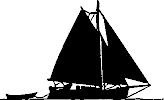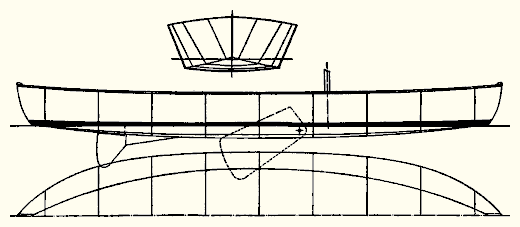
| Davy Jones Too An 18' Flat-Bottom Double-Ended Knockabout By William Atkin |
| A Fast Little Sailer | |
| A useful and fast little sailing boat -- that will be Davy Jones Too. Eighteen feet is a happy length for an open boat: anything under this size is a trifle too small for practical use where the regular crew is two grown persons, and especially if any distance is to be sailed, or rough water encountered. It seems to me that a small sailing boat should be useful and comfortable as well as fast. At this goal I have aimed in designing Davy Jones Too. | |

| |
| Davy Jones Too complies with all the rules prescribed for the Development Class (Suicide Class) and if built exactly as indicated in the plans will give a very good account of herself if raced intelligently in this class. The rig is stem-head sloop with a big mainsail and not too big jib; there seems no good reason where actual sail area is fixed by rule (the Suicide Class has a maximum area of 125 square feet) to use an overlapping jib; this is rather bad in some aspects. | |

| |
The cockpit is 6 feet 9 inches long and 3 feet 9 inches wide at its widest place; 3 feet wide at its narrowest place. There is a single thwart supporting the after end of the center board trunk. Since the foot boards are above the bottom the crew sits on the floor which is the best place to handle a small boat anyway, the weights being low and windage cut to a minimum. There is unusual room for two. There is a water tight bulkhead each end supplying ample floatation in case of a capsize or swamping. All open boats should be obliged to carry water tight compartment or floatation tanks. This latest of MoToR BoatinG's family of worthwhile boats is 18 feet in over all length; 16 feet on the water line; 4 feet 10 inches in breadth; and 9 inches draft to bottom of skeg. With center board lowered the draft is 2 feet. The freeboard at the bow is 1 foot 7 inches: at the stern the same: at the lowest point (amidship) 1 foot 3 inches. The model is a true double-ender; both ends being exactly alike. The sides show generous flare; and flare, in a flat bottomed boat, spells stability. The bottom lines show a slight convexity athwartship similar to the excellent Star class. There is a gentle fore and aft sweep in the profile of the keel and chine lines. The stem and stern profiles are alike. A small skeg breaks the water ahead of the rudder and prevents floating seaweed or grass from lodging and trailing against the rudder post. The boat has a hinged center board, of course. | |

| |
| As I have said before and shall undoubtedly repeat again there Is a lot to be said for the flat bottom model. For sailing it is a better form than the V bottom, and so much simpler to build. When a V bottom boat is heeled down the draft is decreased and the flat of the V is presented to the surface of the water; consequently there is much slapping and shaking wind from the sails. The flat bottom model when heeled down increases in draft and sails on the sharp corner of the chine which is obviously an easier form against a head sea. | |
| Plans for Davy Jones Too are $100 MYSTIC SEAPORT MUSEUM SHIPS PLANS STORE https://store.mysticseaport.org/ships-plans/ shipsplanstore@mysticseaport.org
+1 (860) 572 5360 | |
| BACK TO PLAN LIST | |